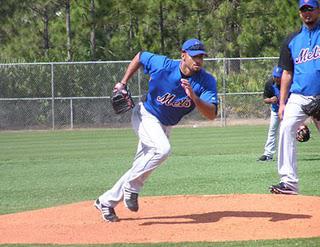
Johan Santana covers first base during PFP
at spring training. Probably the 1 millionth time
he's done so in his career.
Of all the PFP drills that pitchers have to endure, I believe the "I got it, you take it" drill is the most challenging and, therefore, one of the most important.
"I got it, you take it" is a play where a ball is hit slowly in between the first baseman and the pitcher. The challenge of the play involves which of the two are going to get the ball and which of the two are going to cover first base. Obviously, if they both go for the ball then nobody covers first base. If they both go to the bag, nobody gets the batted ball. It's a dilemma that is solved by quick (and loud!) communication between the pitcher and the first baseman.
I'm sure there are different philosophies on how this communication should work but I was always taught that the pitcher must be the one to decide (and yell!) whether he's going for the ball or whether he's going to cover first base. The timing involved in the play requires the pitcher to be the one who controls the decision. He either yells "I got it!" or "Ball, ball!" which means I'm going for the ball or "You take it!" or "Take it, Take it!" which means I'm covering first base. There is one big reason why:
Getting to the bag in time.
Especially with quick runners, a pitcher does not have a lot of time to get to first base in order to cover. If he hesitates even a little the runner may be safe. You don't want the pitcher to go for the ball, then have the first baseman say "I got it!" or "Ball, Ball!", and then have to shift direction and try to cover first base. You want the pitcher to decide immediately whether he is getting the ball or covering first base.
It's not an easy play because an immediate decision is necessary by the pitcher. Once he decides, he probably is not going to have enough time to change his mind. This is why practicing the "I got it, you take it!" play is so valuable. It gives each pitcher the opportunity to practice this decision making and work with the first basemen on the important communication of the play.

